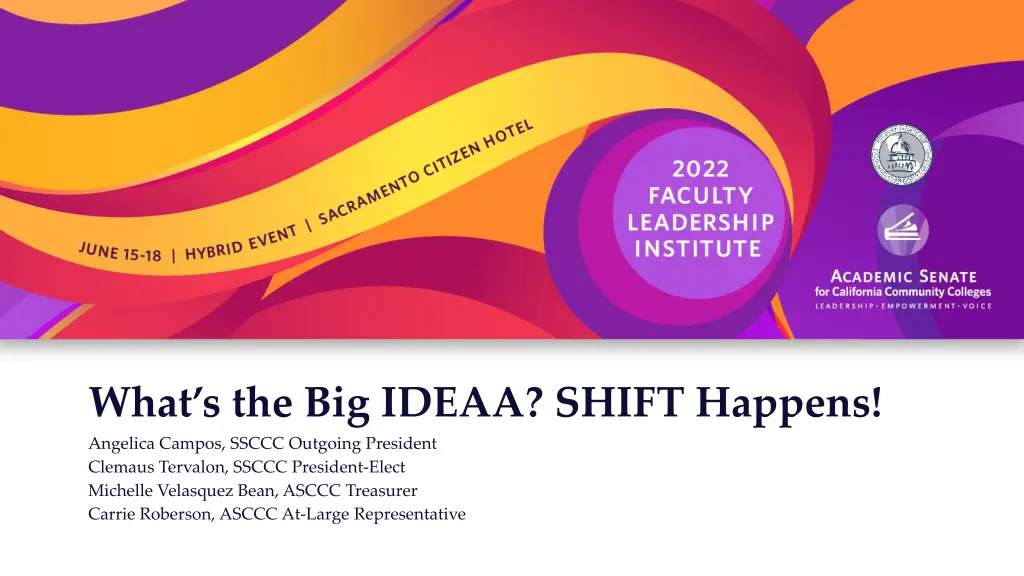
Understanding IDEAA: Shift Happens for Student Success
Explore the importance of IDEAA - Inclusion, Diversity, Equity, Anti-Racism, and Accessibility - in educational systems for supporting student success. Learn about key DEI terms and how to shift campus culture to empower students through empathy, self-awareness, and action.
Download Presentation

Please find below an Image/Link to download the presentation.
The content on the website is provided AS IS for your information and personal use only. It may not be sold, licensed, or shared on other websites without obtaining consent from the author. If you encounter any issues during the download, it is possible that the publisher has removed the file from their server.
You are allowed to download the files provided on this website for personal or commercial use, subject to the condition that they are used lawfully. All files are the property of their respective owners.
The content on the website is provided AS IS for your information and personal use only. It may not be sold, licensed, or shared on other websites without obtaining consent from the author.
E N D
Presentation Transcript
Whats the Big IDEAA? SHIFT Happens! Angelica Campos, SSCCC Outgoing President Clemaus Tervalon, SSCCC President-Elect Michelle Velasquez Bean, ASCCC Treasurer Carrie Roberson, ASCCC At-Large Representative
Today It starts with a mission and a vision supporting students with inclusion, diversity, equity, anti-racism, and accessibility, through IDEAA efforts that is a responsibility of educational systems. Shift happens when faculty and students work together to understand the student experience and create necessary transformations that shift campus culture to support student success. This session is intended to get individuals, as representatives to their colleges, not only to understand the significance of IDEAA, but to also make shift happen to support students through their educational endeavors. 2
I.D.E.A.A. From:(CO Glossary of DEI Terms) Inclusion: Authentically bringing traditionally excluded individuals and/or groups into processes, activities, and decision/policy making in a way that shares power. Antiracism: a powerful collection of anti-racist policies that lead to racial equity and are substantiated by antiracist ideas. Practicing anti-racism requires constantly identifying, challenging, and upending existing racist policies to replace them with anti-racist policies that foster equity between racial groups. Diversity: The myriad of ways in which people differ, including the psychological, physical, cognitive, and social differences that occur among all individuals, such as race, ethnicity, nationality, socioeconomic status, religion, economic class, education, age, gender, sexual orientation, marital status, mental and physical ability, and learning styles. Diversity is all inclusive and supportive of the proposition that everyone and every group should be valued. It is about understanding these differences and moving beyond simple tolerance to embracing and celebrating the rich dimensions of our differences. Accessibility*: An individual with a disability is afforded the opportunity to acquire the same information, engage in the same interactions, and enjoy the same services as a person without a disability in an equally effective and equally integrated manner, with substantially equivalent ease of use. Equity: The condition under which individuals are provided the resources they need to have access to the same opportunities, as the general population. Equity accounts for systematic inequalities, meaning the distribution of resources provides more for those who need it most. Conversely equality indicates uniformity where everything is evenly distributed among people. 3
Shift culture around the student experience Approach inclusion, diversity, equity, anti-racism, and accessibility work with a lens of empathy and humanity Self-awareness is a skill and may involve an emotional response/reaction We are all responsible for our own learning Open-mindedness and self-care are necessary components to take individual action Stamina and persistence through resistance Framework and foundations for action to integrate throughout the college/district Equity work is relational- recognize cultural protocols What else? Your I.D.E.A.A.s 4
Opportunity AND Obligation to support I.D.E.A.A. Traditional views and practices- realities of a biased education IDEAA framework and mindset- Teaching and Learning Learning/ Un-learning Student experience Continuum of efforts, mistakes happen Eliminate equity detours Not just doing what is familiar, but doing what is equitable 5
YOUR TURN! Leadership Empowerment Voice 6
RESOURCES ASCCC PAPER: Going Beyond Development: Faculty Professional Learning An Academic Senate Obligation to Promote Equity-Minded Practices that Improve Instruction and Student Success ASCCC PAPER: Anti-Racism Education in the California Community Colleges ASCCC PAPER: Equity-Driven Systems: Student Equity and Achievement in the California Community Colleges SSCCC Anti-Racism: A Student Plan of Action Equity in the COR Rostrum article Culture and Inclusion Rostrum article 7

